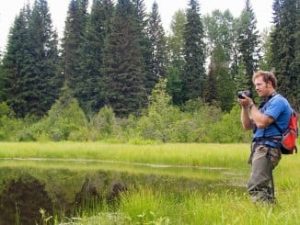Virgil Hawkes
President & Chief Executive Officer, Senior Wildlife Ecologist

2001
- M.Sc.: University of Victoria (Animal Ecology) 2005
- B.Sc.: University of Victoria (Ecological Principles) 1995
Virgil Hawkes, M.Sc., R.P.Bio., has studied wildlife and their habitat relationships in British Columbia and the Pacific Northwest, extending from California to coastal, central, eastern, and the north‐central regions of B.C., as well as portions of the Yukon and Northwest Territories and Alberta for the past 15 years. He has conducted studies of terrestrial and aquatic mammals (e.g., weasels, martens, fishers, wolverines, and beavers), forest birds (e.g., woodpeckers, owls, raptors, and songbirds), waterfowl and songbirds (population estimates and habitat assessments), terrestrial and aquatic amphibians, and reptiles in many regions of B.C., Washington, Oregon, and California. Much of his career has focused on the conservation of rare and endangered species and the interaction between rare and endangered species, their habitats, and human-induced disturbances on those habitats.
Virgil is currently leading several long-term projects to evaluate the impacts of hydroelectric operating regimes on the foreshore development and flora and fauna of reservoirs in British Columbia as well as the impacts that reservoir operational regimes have on rare and endangered species of wildlife. These projects aim to understand how the operational regime of large hydroelectric reservoirs affect the presence and distribution of vegetation and wildlife with a specific focus on songbirds, mammals, amphibians and reptiles, and vegetation communities. In addition, one of these projects is evaluating the efficacy of physical works to improve the suitability of wildlife habitat through long term monitoring of indicator species, which in this case includes aquatic vegetation, aquatic insects, and amphibians. He has also led teams of biologists in the development of natural resource inventories for range and training areas owned by the Department of National Defence in various regions of B.C. which required the development of species lists (flora and fauna) depicting the presence and distribution of those species during all seasons of the year. These projects culminated in the development of long‐term wildlife and vegetation monitoring programs. More recently, Virgil has implemented studies of the return and use of reclaimed lands in the Athabasca Oil Sands region by wildlife, has summarized the use of wildlife habitat models used in EIAs prepared for operations in the oil sands region, and has evaluated the efficacy of the long-term plot network system used to monitor changes in vegetation and soil over time. Much of Virgil’s research incorporates the use of various habitat modelling techniques (e.g., HSI, CAPSU, and RSF) and univariate and multivariate statistics. Virgil has extensive experience conducting research, analyzing and interpreting data, and preparing technical reports and publications. He is a Registered Professional Biologist in B.C. under the College of Applied Biologists and a member of the Association of Professional Biology.
Publications: link to Google Scholar profile.



